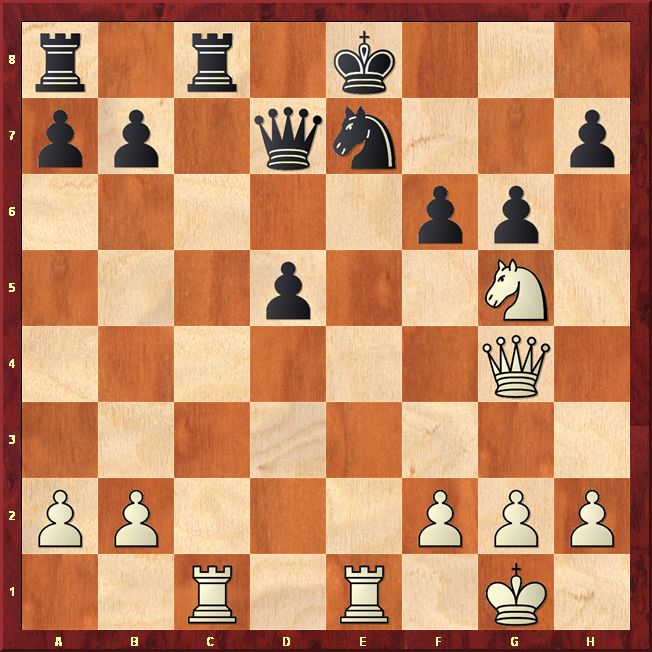Showing posts with label Wilhelm Steinitz. Show all posts
Showing posts with label Wilhelm Steinitz. Show all posts
Tuesday, October 16, 2012
A trap in the Vienna Gambit (I)
The Vienna Gambit (1.e4 e5 2.Nc3 Nf6 3.f4) was popular around the turn of the 20th century, but is rarely seen today. As such, it has the potential to surprise Black. By far Black's best response is 3...d5! One plausible but horrible response is 3...Nc6?, when 4.fxe5 Nxe5 5.d4 5...Nc6 (or 5...Ng6) 6.e5 gives White a position like the Halloween Gambit (1.e4 e5 2.Nf3 Nc6 3.Nc3 Nf6 4.Nxe5?! Nxe5 5.d4) without sacrificing a piece.
Another lemon is 3...exf4?, à la the King's Gambit Accepted. This is a different opening! 4.e5 is very strong for White, whether Black plays the immediate 4...Ng8 or
4...Qe7 5.Qe2 Ng8. Here are a couple of illustrative disasters:
Tuesday, August 17, 2010
Steinitz's Immortal Game
Steinitz - von Bardeleben, Hastings 1895
White to play and win
Admittedly, Hastings 1895 doesn't have much to do with Chicago. But hey, very cool notes by Kavalek!
Wednesday, June 30, 2010
A cheap trap
In the Italian Game (1.e4 e5 2.Nf3 Nc6 3.Bc4), the move 3...Nd4?! wastes time. White should get the advantage by playing 4.Nxd4 or 4.0-0. However, as the game below shows, the move also sets a diabolical trap that may lead to a quick win for Black. It is worth trying in speed chess, albeit not in regular tournament chess unless one is the gambling type. It is tempting for White to try to punish the "silly" 3...Nxd4 by taking the pawn that Black has left unguarded. However, the attractive-looking 4.Nxe5!? actually loses material to 4...Qg5!, forking White's knight and g-pawn. Then 5.Ng4, trying to hold on to the extra pawn, would run into 5...d5! with another double attack, this time on White's bishop and knight. The natural 5.Nxf7 is even worse, as Kostic demonstrates.
White's best after 4...Qg5 is 5.Bxf7+! Ke7 6.0-0!, sacrificing a piece, counting on his two pawns, rolling pawn center and Black's exposed king to provide compensation. Graham Burgess notes G. Chandler-NN, Stockbridge 1983, which concluded 6...Qxe5 7.Bxg8 (7.Bc4!?) Rxg8 8.c3 Nc6 (8...Ne6 9.d4! Qxe4 10.d5 Nf4?? 11.Re1 wins) 9.d4! Qa5? (9...Qf6 10.e5 Qf7 may be best) 10.d5 Ne5? 11.Qh5! Nf7? (11...d6 12.Bg5+ Kd7 13.Qxh7 also wins for White) 12.d6+! 1-0 (in light of 13.Qxa5).
Steinitz mentioned 3...Nd4?! in his Modern Chess Instructor (Part II, 1895, p. 63). The name "Blackburne Shilling Gambit" is sometimes given to the line, on the basis that the great English player Joseph Henry Blackburne, a/k/a "The Black Death" (1841-1924), supposedly used it to win shillings from amateurs. No games have been found to support this claim, but it makes a nice story.
White's best after 4...Qg5 is 5.Bxf7+! Ke7 6.0-0!, sacrificing a piece, counting on his two pawns, rolling pawn center and Black's exposed king to provide compensation. Graham Burgess notes G. Chandler-NN, Stockbridge 1983, which concluded 6...Qxe5 7.Bxg8 (7.Bc4!?) Rxg8 8.c3 Nc6 (8...Ne6 9.d4! Qxe4 10.d5 Nf4?? 11.Re1 wins) 9.d4! Qa5? (9...Qf6 10.e5 Qf7 may be best) 10.d5 Ne5? 11.Qh5! Nf7? (11...d6 12.Bg5+ Kd7 13.Qxh7 also wins for White) 12.d6+! 1-0 (in light of 13.Qxa5).
Steinitz mentioned 3...Nd4?! in his Modern Chess Instructor (Part II, 1895, p. 63). The name "Blackburne Shilling Gambit" is sometimes given to the line, on the basis that the great English player Joseph Henry Blackburne, a/k/a "The Black Death" (1841-1924), supposedly used it to win shillings from amateurs. No games have been found to support this claim, but it makes a nice story.
Subscribe to:
Posts (Atom)
